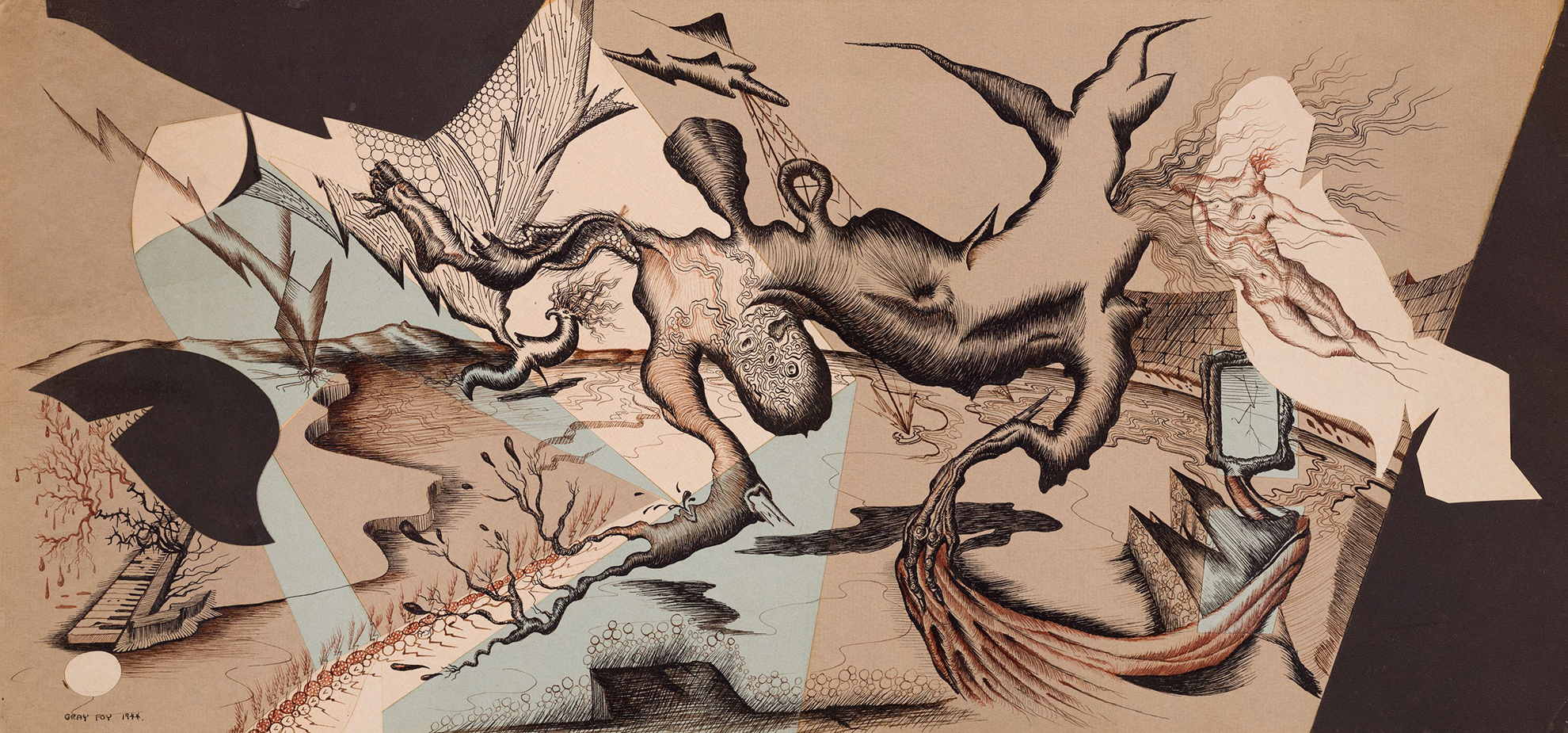“I said, ‘Do you still draw?’
‘No,’ he said.
‘Why did you quit?’ I said.
‘To take care of Leo,’ he said.”
You see, devotion is a full-time job.
After Foy died in 2012, a stash of his drawings was discovered in his apartment, most of which was reportedly hidden in drawers and closets. The Menil Drawing Institute is bringing many of those works to light in Hyperreal: Gray Foy, on view through Sept. 3, the first solo museum exhibition of the artist’s work.
Hyperreal spans Foy’s career from the 1940s to the 1970s, and marks two recent gifts to the Menil of approximately 80 drawings. Although the art world had mostly forgotten about Foy prior to his self-determined career end, renewed contemporary interest in his work is a result of a major multi-year research and conservation project that ensued after the artist’s death, initiated by his devoted supporters. That project culminated in a 2018 exhibition at Francis Naumann Fine Art in New York City and a significant monograph, Gray Foy: Drawings 1941–1975, from editor and contributing author Don Quaintance, published by Callaway.
Born in Dallas, Foy grew up in Los Angeles and moved to New York in the late 1940s. He studied at Southern Methodist University and Columbia University, attaining some critical success and winning a Guggenheim grant in 1961. He also maintained an interest in set design and commercial illustration.
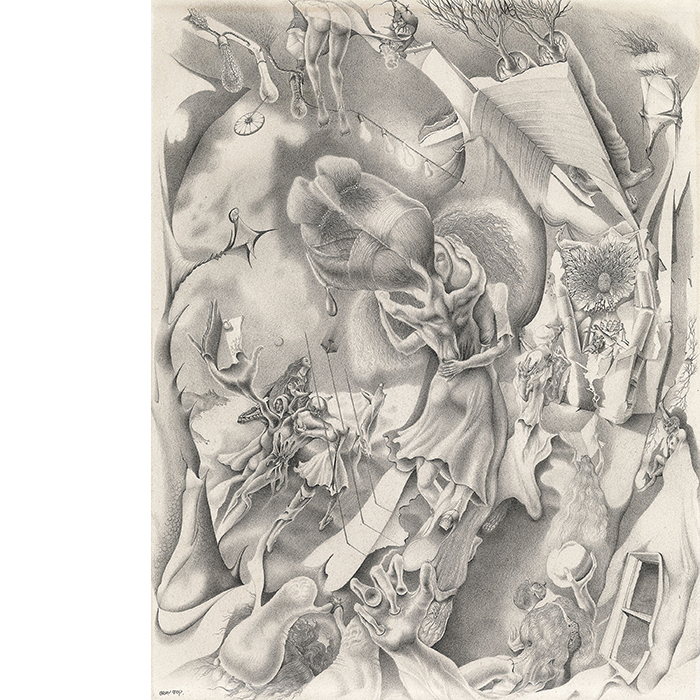
1 ⁄9
Gray Foy, Untitled [Illuminated Exterior with Morphing Dancers], ca. 1946. Graphite on paper, 13 1/4 × 10 1/2 in. (33.7 × 26.7 cm). Collection of Marguerite Steed Hoffman. © Estate of Gray Foy. Photo: Photographic Works, Tucson, Arizona

2 ⁄9
Gray Foy, Untitled [Nudes Emerging from Botanical and Avian Forms], 1948. Graphite on paper, 11 3/4 × 9 in. (29.8 × 22.8 cm). The Menil Collection, Houston, Anonymous gift. © Estate of Gray Foy. Photo: Caroline Philippone

3 ⁄9
Gray Foy, Untitled [Interior with Woman Standing at a Dresser], 1946. Graphite on paper, 13 3/4 × 11 in. (34.9 × 27.9 cm). The Menil Collection, Houston, Gift of the estate of Gray Foy. © Estate of Gray Foy. Photo: Caroline Philippone

4 ⁄9
Gray Foy, Untitled [Interior with Distorted Figures and Armoire], ca. 1944. Graphite on paper, 8 × 4 3/4 in. (20.3 × 12.1 cm). The Menil Collection, Houston, Gift of the estate of Gray Foy. © Estate of Gray Foy. Photo: Graham S. Haber

5 ⁄9
Gray Foy, Untitled [Cluster of Leaves], ca. 1957. Graphite, watercolor, and opaque watercolor on paper, 7 1/4 × 10 7/8 in. (18.4 × 27.6 cm). The Menil Collection, Houston, Anonymous gift. © Estate of Gray Foy. Photo: Graham S. Haber
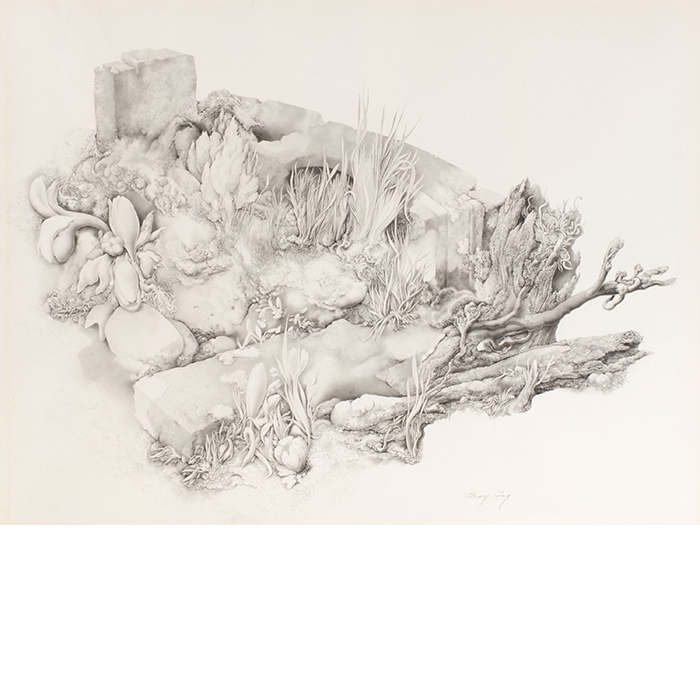
6 ⁄9
Gray Foy, Untitled [Architectural Fragment Overgrown with Plants], ca. 1969. Graphite on paper, 12 3/4 × 16 3/4 in. (32.4 × 42.5 cm). The Menil Collection, Houston, Anonymous gift. © Estate of Gray Foy. Photo: Caroline Philippone

7 ⁄9
Gray Foy, Dimensions, c.1945–46. Pencil on paper, 21 1/2 x 27 3/4 in. (54.6 x 70.5 cm). The Museum of Modern Art, New York, Gift of Steve Martin, 2005. © Estate of Gray Foy. Photo: John Wronn
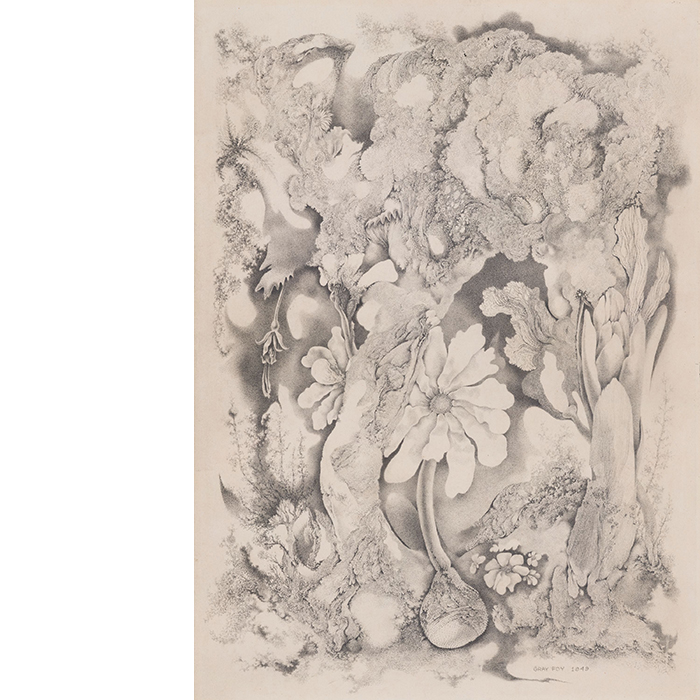
8 ⁄9
Gray Foy, The White Flower, 1949. Graphite on paper, 10 × 6 3/4 in. (25.4 × 17.1 cm). The Menil Collection, Houston, Anonymous gift. © Estate of Gray Foy. Photo: Caroline Philippone
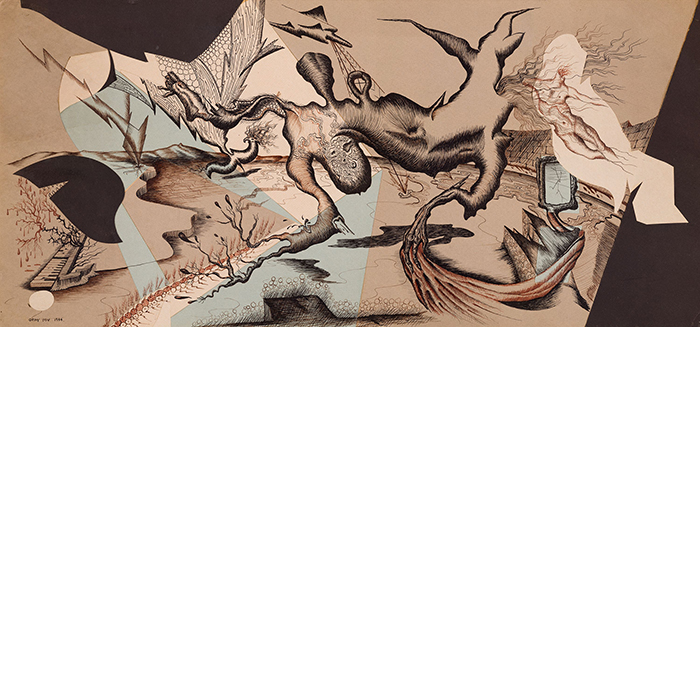
9 ⁄9
Gray Foy, Untitled [Landscape with Figure and Treelike Forms], 1944. Ink on paper collage mounted to board, 9 3/4 × 20 7/8 in. (24.8 × 53.1 cm). The Menil Collection, Houston, Gift of the estate of Gray Foy. © Estate of Gray Foy. Photo: Caroline Philippone
Foy rarely worked from life, instead relying on his imagination. His early works embody the influence of Surrealism, though he resisted the label, and later works depict nature motifs. His precision and attention to detail are astounding.
“Later on in his life, when he had less time to devote to drawing, we see him creating less, as he had greater domestic responsibilities, among other reasons. The type of drawings he did took a lot of time, took a lot of patience and concentration. He’d spend months, sometimes even a full year, on a single work,” Marples says.
She also says that, during the war, Foy committed to working primarily in graphite on paper, creating works that, for her, “speak to a sense of wartime unease.” Additionally, the works on view, which include Foy’s commercial illustrations, test our dedication to our perceptions of the world around us.
“Grape Hyacinths and Fungi, for example, looks somewhat straightforward at first glance, but when you look more carefully, not only does his technique blow your mind, I think you can appreciate this notion of the hyper-real, which is my guiding concept for the show. He’s playing with scale and perspective, rendering the natural world unfamiliar, and allowing us as beholders to bring our own imaginations to the drawings.”
—NANCY ZASTUDIL

